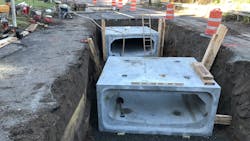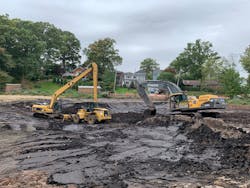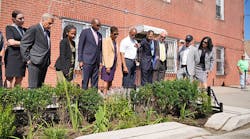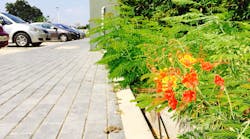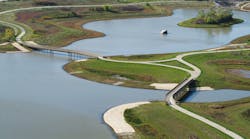The New York City Departments of Environmental Protection (DEP) and Design and Construction (DDC) made the announcement last week. The infrastructure investment upgraded the drainage systems in the neighborhoods of Tottenville, Eltingville and Great Kills on the South Shore of Staten Island.
The projects included the addition of new catch basins and storm sewers to improve roadway drainage and wetlands to naturally filter the stormwater. In addition, new water mains and fire hydrants were added along with new sanitary sewers, which allows hundreds of homes to now connect to the city sewer system and discontinue the use of septic tanks. DEP provided the funding for the projects and DDC managed the construction.
The award-winning Bluebelt program preserves natural drainage corridors such as streams, creeks, and ponds, and optimizes them to help control and filter stormwater from surrounding neighborhoods. The Bluebelts also provide open spaces and serve as a habitat for diverse wildlife. Over the last 25 years DEP has built more than 70 Bluebelts across Staten Island with additional sites currently in construction and design.
“These three Bluebelt projects represent over $135 million invested in Staten Island’s infrastructure and extend an incredibly unique and innovative approach to stormwater management for the borough,” said DDC Deputy Commissioner for Infrastructure Eric Macfarlane. “We are pleased to have worked with DEP on dozens of projects throughout the last two decades to alleviate flooding and improve the quality of life for residents throughout the Island.”
Tottenville
In Tottenville, a $53.8 million project transformed a swampy marshland filled with debris and Phragmites into the beautiful 4.4-acre Mill Creek Bluebelt. Two stone-faced outfalls, one at the end of Murray Street and the other along Amboy Road, will direct stormwater from the upgraded drainage network into the newly built holding ponds.
As part of the project, more than 8,200 linear feet of new storm sewers and 90 new catch basins were installed. In addition, more than 11,600 linear feet of new sanitary sewers allowed 210 homes to connect to the City’s sewer system and discontinue the use of septic tanks.
“The Bluebelts on Staten Island are among the most successful common sense infrastructure projects in our borough’s history. The brilliant team at DEP developed the concept of engineering our existing stream corridors to redirect stormwater away from neighborhoods and into natural areas," said Staten Island Borough President James Oddo. “The result is help for residents in low-lying areas prone to flooding and the creation of ponds and wetlands that beautify our borough and increase property values. I applaud Mayor de Blasio, DEP and DDC for continuing to invest in and expand the Bluebelt program—particularly at a time of increasingly severe and damaging storm systems affecting our Island.”
To improve the drinking water distribution system, more than 12,400 linear feet of new water mains made from concrete-lined ductile iron, which is more resilient and less prone to breakage, were added to replace older cast iron pipes. A micro-tunnel boring machine was utilized to excavate a passage beneath the Richmond Valley stop of the Staten Island Railway station for sewer and water lines without disrupting train service.
Fire protection was enhanced with the installation of 43 new fire hydrants and replacement of 28 old fire hydrants. Roadways, sidewalks and curbs were rebuilt and portions of Page Avenue and Amboy Road were widened and turning lanes were added to improve safety and improve the flow of traffic. Throughout the project area, 118 new trees were planted.
Great Kills
In Great Kills, the City invested $46 million to improve drainage and rehabilitate Jack’s Pond, which included the substantial removal of accumulated pond sediment to re-establish historic elevations, grading, and pond depth to increase the storage capacity of the Pond. In order to naturally treat the water and reduce algae blooms, thousands of native wetland plants were added and a solar powered aerator was installed in the pond. The plants absorb the algae while the solar powered aerator oxygenates the water via three underwater diffusers. New upland vegetation was also planted and native fish, including hundreds of largemouth bass and bluegill sunfish and thousands of fathead minnows, were stocked in the restored pond.
Eltingville
Finally, in neighboring Eltingville, the city undertook a $35.8 million project to upgrade the drainage and water delivery infrastructure. Three natural drainage systems were built in the vicinity of the Wood Duck Pond Bluebelt, reducing roadway flooding by collecting stormwater from surrounding roadways and directing it to this wetland where it is naturally filtered in order to protect the environment.
Construction included the installation of 6,600 linear feet of stormwater sewers and over 7,800 linear feet of sanitary sewers, the replacement of more than two miles of new water mains, and the addition of 114 new catch basins and 34 new fire hydrants. As part of the final street restoration, portions of the roadway were raised by up to three feet and more than 33,000 square yards of roadway was reconstructed, and more than 22,000 linear feet of sidewalks were reconstructed. New plantings, including in the vicinity of the new drainage wetlands, totaled more than 160 trees and 420 shrubs.
SOURCE: New York City Department of Environmental Protection

